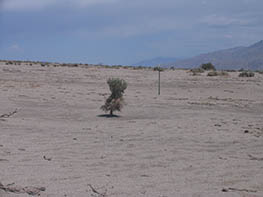Mitigation Projects

The Inyo-LA Long Term Water Agreement (LTWA) and associated EIR and MOU call for numerous projects to mitigate impacts of DWP’s water gathering activities during the 19 years of litigation leading to the LTWA. According to Inyo County Water Department’s (ICWD’s) 2013-2014 Annual Report, there are approximately 49 mitigation projects. Of these, 26 have been implemented with reasonable success, while the rest all have various problems, and some have not even been started.
Of particular concern is the mitigation requirement that “stands of tree willows and cottonwoods” (EIR, pg. S-6) will be monitored. As of 2015, twenty-four years after the signing of the LTWA, the Technical Group has never even agreed on where all the stands of tree willows and cottonwoods are (were, because many have now died), much less developed a monitoring protocol to insure they are not impacted by water management.
Some of the projects were nonsensical to begin with. For example, three mitigation projects cause the impacts they are mitigating. These projects involve pumping particular wells which dry up springs, whose drying the pumping is supposed to mitigate (of course, the rate of pumping exceeds the rate at which the springs previously flowed).
About 1300 acres of land are designated for mitigation in the form of re-vegetation projects. Most these simply call for trying to establish a low cover of upland species in areas formerly occupied by high-cover groundwater-dependent meadows. The idea that this is biologically meaningful “mitigation” is laughable. And in several large areas even this meaningless “mitigation” is failing badly.
Reading the table of mitigation projects in the Inyo County Water Department’s annual report is a good way to get an idea of how much damage DWP has done to Owens Valley. The fact that so many of these projects – biologically questionable to begin with — haven’t even been successfully implemented is compelling evidence of the failure of the LTWA.
The single largest and most important mitigation is the Lower Owens River Project (LORP). Because the project is addressed in the MOU – as well as the LTWA/EIR – OVC has had legal standing to enforce its implementation. Because DWP failed to meet project deadlines while trying to change critical features of the project it took three lawsuits by OVC and the Sierra Club to finally get the LORP implemented according to the intent of the LTWA and MOU.
For mitigation projects DWP has yet to complete, it has unilaterally decreed a “water neutrality” policy. This means if DWP must use water for a mitigation project in the valley, it insists it be allowed to gather more water (typically by getting an exemption from the on/off protocol) so its exports will not be affected. This policy is not in the LTWA/EIR/MOU, yet Inyo has repeatedly acquiesced to DWP’s imposition of it.
The Big Pine re-greening project is a notable example. The Inyo County Water Department supported DWP’s demand for an exemption and rationalized its support by ignoring cumulative valley-wide impacts of DWP’s already-excessive exempt-well pumping. It also ignored any discussion of the justice – or lack thereof — of the concept of exemption in the name of mitigation
When DWP requires an exemption as a condition for mitigation, it, in effect, makes the victim compensate the perpetrator of the (environmental) crime. A basic concept in US environmental law is “the polluter pays”. Here, the perpetrator of the environmental impact (DWP) pays, but gets reimbursed by the victim (Inyo) in the form of a well exemption. This stands justice on its head and makes a joke of the entire concept of mitigation.
The DWP and Inyo County Water Department have released these tables of Mitigation Projects that still need completion. Areas where there are disagreements are marked by where Inyo County or the DWP feels that particular project is on meeting goals. There is some disagreement from the public about where some of these mitigation projects completion. Here are the tables:
